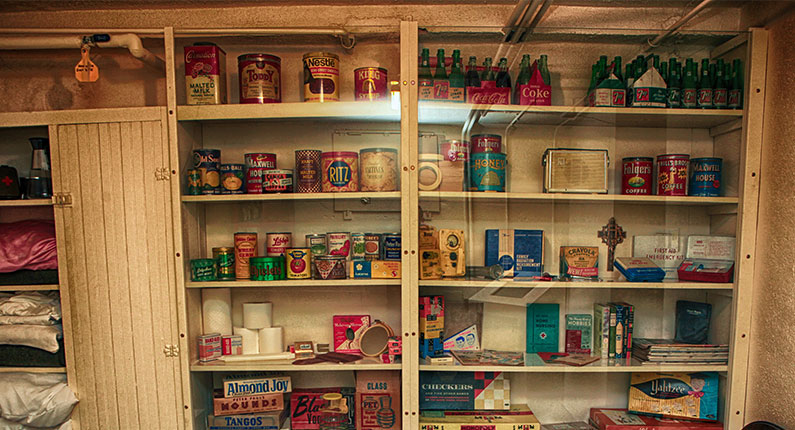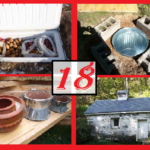DIY: Wall-Hanging Canned Food Storage

Photo: survivehive
Everyone needs more storage! No home ever built has enough, once you have it you fill it. But this is especially true of preppers. That doesn’t mean we can afford infinite storage space. But it does make us a bit more creative on how we do store things and how we find the room to do so.
The featured article is how one prepper made use of unused space to make it work.
** Admin Note: We have become aware that at this time Survive Hive is having issues with their site. So I have temporarily pulled the instructions from the internet archive and posted them below.
Today, Survivehive takes a much needed look back upon one of the best DIY projects we’ve ever come across: the DIY Wall-Hanging Canned Food Storage. This DIY project was brought to our attention in the earlier incarnations of our website. This incredible fellow and his wife had (then) recently moved into their new home. They realized that they had a gem on their hands pretty quickly. There was an unfinished, stud-exposed wall in one of the best storage places ever: under the stairs.
The couple was quick to realize that they could turn that space into a vertical canned food rotation system. The way they measured everything, they would have enough space for around 195 cans. They were kind enough to share their process with us. Here are the plans as told by the man himself.
The section size: 4’ x 76”
Materials:
1 Box of 1 ½ inch wood screws
1 4’x8’ sheet of ½” plywood
1 2”x4”x36”
1 5.5” piece of scrap
1 4.75” piece of scrap
1 1”x8”x96”
1 1”x2”x96”
14 1”x4”x48”
14 1”x3”x48”
Tools:
Drill driver
Table saw
Tape measure
Pencil (for markings)
The Cut
The process begins with cutting the plywood into the dimension of your area. As fitting your area, they cut each of the 1”x4” pieces to 39”. They had gone with a shorter cut in order to allow more room for the 1”x8” which shall be along the bottom to house the cans. A gap of 3.5” at the top in order to load your cans in.
Process to cut 1”x3” pieces to a 35.5” and leave a 3.5” at the bottom. This shall enable you to remove any cans that you put in.
Cut 13 small angled pieces off of the 2”x4” in order to lie at the base of each column.
The 1”x8”x96” and the 1”x2”x96” to 76” which is longer so that it would accompany the length of the wood.
Use scrap lumber to cut a 5.5” and 4.75” piece of 1”x4”.
The Build
Hold a 1”x4” piece against the short side of the wood and draw a line. The line should be 3.5” down from the top or the long side of the wood.
Make use of a small drill bit to sufficiently drill pilot holes in the middle of the .75” area in between the right edge of the plywood and the line. This will enable you to hold the 1”x4” against the top line and left line.
Make use of the holes to screw in the 1”x4” along the right edge and the line. Make sure that everything aligns well. Then take up the 4.75” spacer and butt it against the vertical 1”x4”. Draw a parallel line away from the 1”x4”
Repeat with the 5.5” spacer. Make use of the two parallel lines .75” apart to find out where your next vertical 1”x4” will go.
Drill pilot holes between the two lines you made. Repeat previous steps until all vertical sections are fully in place. Butt the 1”x8” horizontally against the bottom of the vertical 1”x4” and screw it into each of the 1”x4”s on the bottom.
Place the 1”x2” at the end of the 1”x8” and screw it in place. This will ensure that your cans won’t just roll off. From there, take your 1”x3” pieces and other than the farthest left and right points, center them unto the 1”x4” vertical pieces and screw them in. These will serve as the key to stack your cans.
Cut off any excess width from the sides. Take your angled pieces of 2”x4” and screw them into the top of the 1”x8” centered in each of your columns. They will push the cans out toward the lip.
Enjoy your creation!
Originally published on Survive Hive as: Throwback to a Good DIY: Wall-Hanging Canned Food Storage
 This is an aggregated site. Please be aware some of the sites we link you to could have pop ups. We have no control over them. However, we will never link you to a site that requires you to make any purchase to view the blog.
This is an aggregated site. Please be aware some of the sites we link you to could have pop ups. We have no control over them. However, we will never link you to a site that requires you to make any purchase to view the blog.
Please read our disclaimer. We provide you with information from various sites all over the world. The author’s expressed opinion isn’t necessarily that of The Prepared Page or its staff. Our intent is to bring you the information. Use your and your own best judgment when using any information contained within the blogs.
While you’re here check out some of those other posts you may find them interesting!!!
Some posts may contain affiliate links.







